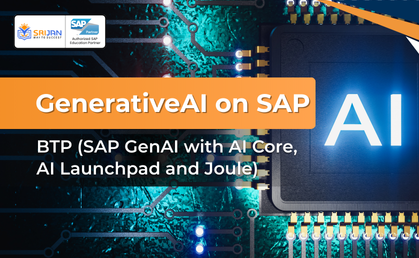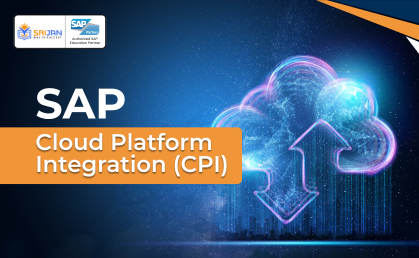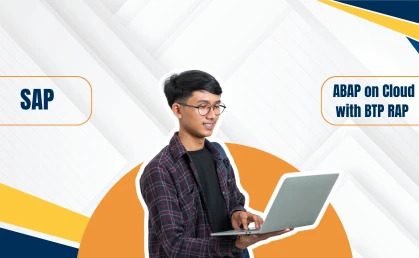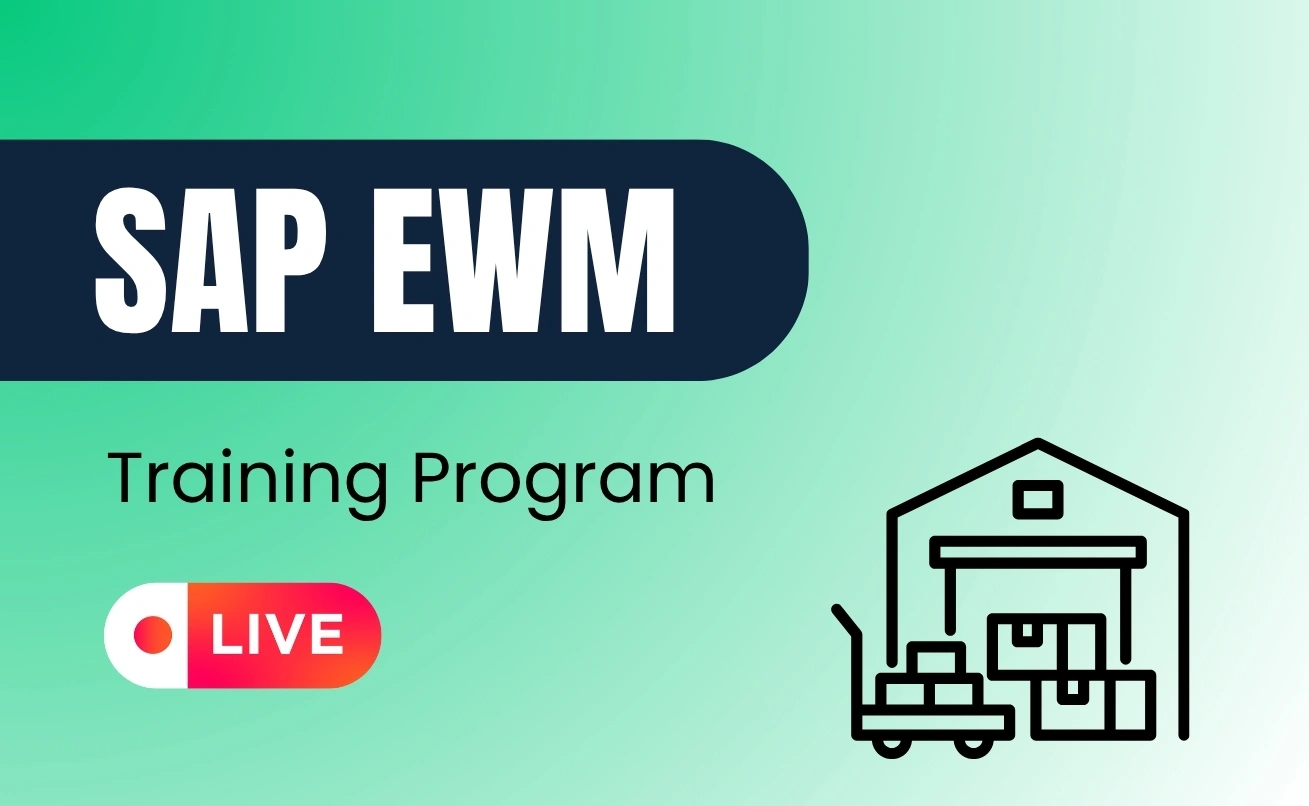Today, big companies have large warehouses where they keep all their goods before sending them to shops or customers. Managing a warehouse is not easy. You must know what items come in, where they are kept, and when they go out. To make this easy, companies use a special computer system called SAP EWM.
SAP EWM stands for Extended Warehouse Management. It helps companies run their warehouses in a smart, fast, and correct way. If you want to learn how this works, joining an SAP EWM course online is a great idea. You can learn from home and get ready for a good career in logistics and supply chain.
What is SAP EWM Course Online?
SAP EWM course online is a part of the SAP software that helps in handling warehouses or stocks. It tells you where all things are kept, how many products are in stock or what we need to restock, and when items move in or out from the company.
Think like, if a company sells products like toys, SAP EWM course online helps them know how many toys are in the stock, which boxes are full or empty, and when new toys need to be sent to shops. It keeps all the warehouse work proper and saves time.
Why Learn SAP EWM Course online?
Learning the SAP EWM course online is very useful because every company needs people who can manage their warehouses properly. From online shopping companies to big factories, everyone stores goods somewhere.
If you know SAP EWM Course Online, you can help for the companies to do work faster and better. You also get a chance to earn a good salary and build a strong career. It is a great skill for the future because more and more businesses are using SAP systems today.
What You Will Learn in the SAP EWM Course Online
In the SAP EWM online course, you learn step by step how to manage a warehouse using SAP software. You don’t need to be a computer expert just basic computer knowledge is enough for strting the SAP Courses.
You will first learn what a warehouse is, how goods come in, how they are stored, and how they go out for delivery. Then, you’ll learn how to do these things inside the SAP system.
You’ll study topics like:
- How to check stock and manage inventory.
- How to find where items are kept in the warehouse.
- How to handle goods when they come in (inbound) and go out (outbound).
- How to track and move materials easily.
You’ll also learn how SAP EWM connects with other SAP modules like SAP MM course (Material Management) and SAP SD course (Sales and Distribution). This helps you understand how all parts of a company work together.
By the end of the course, you will know how to use SAP EWM for real work — just like professionals do in big companies!
SAP EWM Course Online Training with Srijan Institute
Learning SAP EWM Course online in India has become very popular. You don’t need to go anywhere; you can learn from your home using your computer or laptop.
Online classes include live classes with expert trainers, doubt solving sessions, and practical projects. You’ll also get study materials and recorded videos to revise anytime you want.
Some institutes even help you get ready for interviews and find jobs after you complete the training or course. So, online learning is a comfortable and the best choice.
Career Opportunities After SAP EWM Course
Once you finish the SAP EWM course online, you can apply for many jobs like:
- SAP EWM Consultant
- Warehouse Process Expert
- Logistics Executive
- Supply Chain Analyst
Every big company needs people who can manage their warehouse systems properly. You can work in industries like e-commerce, manufacturing, retail, or transport.
As you get experience, you can shift to senior positions like SAP Project Manager or SAP Solution Architect, where you help teams and plan big warehouse systems for companies.
Who Can Join the SAP EWM Course?
The SAP EWM course online is for anyone who wants to learn about warehouse management and all functions. You don’t need to be a computer expert or have technical experience. If you are curious about how goods are stored, moved, and tracked in big companies, this course is perfect for you.
Students who have completed their graduation or are still studying can join. It’s also a great option for freshers who want to start their career in SAP or supply chain management.
People already working in logistics, inventory management, warehouse functions, or SAP MM and SD courses can also join to improve their skills and move to advanced roles.
Even if you come from a different background, such as commerce, business, or operations, you can easily learn SAP EWM because the course is taught step by step easily.
In short, anyone a student, fresher, or working expert who wants to make a better, high-paying, and future-ready career can join the SAP EWM online course and start learning today.
Why Choose SAP EWM Online Course?
Online learning is the best way to learn SAP EWM courses online today. You can study from anywhere, choose your class timing, and learn directly from industry experts.
You don’t have to travel or follow strict schedules. The SAP EWM course online includes hands-on practice so that you learn by doing. You can also talk to trainers, join live discussions, and solve real case studies — all from your home!
This makes online courses flexible, fun, and easy for everyone — students, beginners, and working professionals.
Conclusion
The SAP EWM Course Online is one of the best courses for anyone who wants to start a career in supply chain or warehouse management. It teaches you how warehouses work and how to use SAP software to make them run properly.
You don’t need to be a technical person to start. The course is simple, practical, and includes useful sessions. After learning SAP EWM, you can get good jobs, earn well, and work in big companies in India and abroad.
If you like setting up things, planning, and using technology, then learning SAP EWM course online is the best next step for you. It’s your chance to have a perfect and successful career!
The fee for SAP EWM (Extended Warehouse Management) training can vary depending on several factors such as the location, duration of the course, training format, and level of expertise. SAP offers various training options for EWM, including instructor-led courses, e-learning courses, and virtual live classrooms.
For More details you can Register
SAP EWM(Extended Warehouse Management) Certification:
SAP EWM Certification is a formal recognition of a person's expertise and knowledge in SAP Extended Warehouse Management (EWM) solution. EWM is an advanced warehouse management system that provides comprehensive support for warehouse operations, inventory management, and distribution processes.
There are three levels of SAP EWM certification: Associate, Professional, and Master. Each level of certification requires candidates to pass a different set of exams that test their knowledge of SAP EWM functionality, configuration, and integration with other SAP modules.
To be eligible for SAP EWM certification, candidates must have a minimum of two years of experience in SAP EWM implementation or support projects. However, SAP recommends that candidates have a minimum of four years of experience in SAP EWM.
The SAP EWM certification exam consists of 80 multiple-choice questions, and candidates have three hours to complete the exam. The passing score for the exam is 63%. The exam can be taken at any of the authorized SAP training centers or testing centers around the world.
SAP EWM(Extended Warehouse Management) Curriculum:
SAP EWM INTRODUCTION AND OVERVIEW
Introduction to ECC – WM
Extended Warehouse Management
Difference Between WMS and EWM
QRFC Connection (Between ECC and EWM) Setup complete SAP EWM
ECC ORGANIZATION STRUCTURE OVERVIEW
Plant, Storage Location, Shipping Point, Shipping Condition, Loading Group.
Mapping Plant/ Storage Location to ECC –> Warehouse
Link ECC –> Warehouse
EWM STRUCTURE
Organizational Units in EWM
Warehouse, Storage Type, Activity Areas
MASTER DATA IN EWM
Master Data Creation
CIF Process Overview
CIF Exercise
Vendor Master –> BP Roles
Customer Master –> BP Roles
Product Master
Bin Master — Create/Change/View
Pack spec Overview
Master Data
TRANSACTION DATA OVERVIEW
Outbound Delivery Flow
Inbound Deliver Flow SAP EWM online, ewm100 pdf,
Linking ECC –> EWM Documents
EWM DOCUMENTS
Inbound Delivery Notification
Inbound & Outbound Delivery
Outbound Delivery Notification
Outbound Delivery Order
Warehouse Order
Warehouse Task
GR AND INBOUND PROCESS
Putaway Process and strategies
Process Oriented Storage Control – POSC
Layout Oriented Storage Control – LOSC
Packing, HU Management, Pack spec
Deconsolidation
VAS
EWM Quality Management
Putaway Strategies:
Fixed Storage Bin
Addition to Existing Stock
General Storage
Empty Storage bin
Near Fixed Picking bin
Pallet Storage
Bulk Storage
GI AND OUTBOUND PROCESS
GI Process and Stock Removal Strategies
Packing Specifications and Condition technique for packing specifications
WOCR
Wave Processing
Replenishment
STOCK REMOVAL STRATEGIES
FIFO
LIFO
SLED
Fixed Storage bin
WAREHOUSE MONITOR
Monitor Overview
Warehouse Management Monitor
Monitor Capabilities
Configuration of Warehouse Monitor
HANDLING UNIT MANAGEMENT
Packaging Materials
Packaging Specifications
During Deliveries
Work centre
WT confirmation
Packing using RF
Deconsolidation using RF
RESOURCE MANAGEMENT
Resource, Resource Type, Resource Group
Assignment of Warehouse Order to Resource
Queue’s
WAVE MANAGEMENT
Wave
Processing of Waves
VALUE ADDED SERVICES
VAS order
GR process with VAS order
GI process with VAS order
Warehouse internal process with VAS order
RFID
Configuration settings for RFID
RFID process in GR and GI process
Auctions in RFID:
Automatic Loading and Unloading with RFID
Automatic Packing with RFID
RFID with Resources
SAP EWM(Extended Warehouse Management) Interview Questions & Answers:
1. What is SAP EWM, and how does it differ from SAP WM?
A: SAP EWM (Extended Warehouse Management) is a software system that manages the flow of goods in a warehouse. It offers more advanced features than SAP WM (Warehouse Management), such as enhanced inventory tracking, yard management, and wave management.
2. What are the different processes in SAP EWM?
A: The processes in SAP EWM include inbound processes, outbound processes, internal processes, and storage processes. Inbound processes deal with receiving and putaway, outbound processes deal with picking and shipping, internal processes deal with transfers between storage bins, and storage processes deal with inventory and space management.
3. What is a delivery document, and how is it used in SAP EWM?
A: A delivery document is a document that contains information about a customer order, including the products that need to be shipped, the quantity of each product, and the delivery date. It is used in SAP EWM to manage the outbound processes, including picking and shipping.
4. What is the difference between inbound and outbound delivery in SAP EWM?
A: Inbound delivery refers to the process of receiving goods into the warehouse, while outbound delivery refers to the process of shipping goods out of the warehouse. Inbound delivery includes activities such as unloading, putaway, and quality inspection, while outbound delivery includes activities such as picking, packing, and shipping.
5. What is a warehouse order, and how is it used in SAP EWM?
A: A warehouse order is a document that contains instructions for the movement of goods within a warehouse. It is used in SAP EWM to manage the storage and retrieval of goods, as well as other warehouse processes such as picking, packing, and shipping.
6. What is the difference between a warehouse task and a warehouse order?
A: A warehouse order is a high-level document that contains instructions for the movement of goods within a warehouse, while a warehouse task is a specific activity within a warehouse order. For example, a warehouse order might contain instructions for picking a certain quantity of a product, while the corresponding warehouse task would be the actual physical picking of the product.
7. What is a handling unit, and how is it used in SAP EWM?
A: A handling unit is a physical unit of goods that is used for storage and transportation within a warehouse. It can contain one or more individual products, and is tracked using a unique identification number. Handling units are used in SAP EWM to simplify the tracking and management of inventory.
8. What is cross-docking, and how is it used in SAP EWM?
A: Cross-docking is a process in which goods are received into a warehouse and immediately shipped out without being stored. It is used in SAP EWM to streamline the inbound and outbound processes, and can help reduce storage costs and improve efficiency.
9. What is the difference between a storage bin and a storage type in SAP EWM?
A: A storage bin is a physical location within a warehouse where goods are stored, while a storage type is a group of storage bins with similar characteristics, such as temperature or weight capacity. Storage types are used in SAP EWM to help manage the storage and retrieval of goods, and to optimize warehouse space.
10. What is the difference between a physical inventory and a cycle count in SAP EWM?
A: A physical inventory is a complete count of all inventory in a warehouse, while a cycle count is a periodic count of a small subset of inventory. Physical inventories are typically performed annually or bi-annually, while cycle counts are performed more frequently to help maintain inventory accuracy.
11. What is the difference between a product and a material in SAP EWM?
A: In SAP EWM, a product is a finished good or a semi-finished good that is ready to be sold or used in production, while a material is any item that is used in the manufacturing process or is part of a finished product. Materials can include raw materials, packaging materials, and spare parts.
12. What is wave management in SAP EWM?
A: Wave management is a process in SAP EWM that groups together multiple warehouse orders or tasks into a single processing wave, which can be executed together to optimize warehouse efficiency. It is used to manage inbound and outbound processes, and can help reduce processing times and increase throughput.
13. What is slotting in SAP EWM?
A: Slotting is a process in SAP EWM that involves the strategic placement of products within a warehouse based on their characteristics, such as size, weight, or demand. It is used to optimize the use of warehouse space and increase efficiency, by ensuring that products are stored in the most appropriate locations.
14. What is the difference between a warehouse task monitor and a warehouse order monitor in SAP EWM?
A: A warehouse task monitor in SAP EWM provides real-time visibility into individual warehouse tasks, such as picking or putaway, while a warehouse order monitor provides visibility into higher-level warehouse orders that contain multiple tasks
15. What is the difference between a replenishment order and a transfer order in SAP EWM?
A: A replenishment order is used to move goods from a bulk storage area to a picking area, in order to ensure that inventory is always available for picking. A transfer order, on the other hand, is used to move goods from one storage bin or storage type to another, in order to optimize space utilization or accommodate changes in demand.
16. What is a warehouse monitor in SAP EWM?
A: A warehouse monitor is a tool in SAP EWM that provides real-time visibility into warehouse operations, including inventory levels, order status, and employee productivity. It can be used to identify potential bottlenecks, monitor key performance indicators, and make informed decisions about warehouse operations.
17. What is a slotting strategy in SAP EWM?
A: A slotting strategy in SAP EWM is a set of guidelines or rules that govern the placement of products within a warehouse. It can take into account factors such as product size, weight, demand, and turnover rate, and can help ensure that products are stored in the most efficient and effective manner.
18. What is the difference between a storage unit and a storage bin in SAP EWM?
A: A storage unit is a logical grouping of storage bins, such as a shelf or a pallet, that is used to track inventory. A storage bin, on the other hand, is a physical location within a warehouse where goods are stored. Storage units are used in SAP EWM to simplify inventory tracking and management.
19. What is the difference between a picking area and a bulk storage area in SAP EWM?
A: A picking area is a section of a warehouse where products are stored in a way that makes them easy to access and retrieve for picking, while a bulk storage area is a section of a warehouse where products are stored in large quantities, often on pallets or in bins. Picking areas are typically located close to the shipping area, while bulk storage areas are used to optimize warehouse space.
20. What is the difference between a stock type and a stock category in SAP EWM?
A: A stock type in SAP EWM is a classification that is used to define the status of inventory, such as unrestricted stock, blocked stock, or quality inspection stock. A stock category, on the other hand, is a grouping of stock types that is used to define the material flow within a warehouse, such as inbound, outbound, or internal movements.
Participants will have 24/7 access to our online lab, providing hands-on experience with SAP MM tools and scenarios.
This includes server access to S/4 HANA 2023 for 1 year, ensuring you have ample time to practice and apply your skills in a real-world environment.
With this extended access, you can work on projects, explore advanced features, and solidify your understanding of SAP EWM in the latest SAP S/4 HANA version.
0
Satisfied Students0
Years of Excellence0
Practical TrainingCourse Certification
SAP EWM(Extended Warehouse Management) Certification:
SAP EWM Certification is a formal recognition of a person's expertise and knowledge in SAP Extended Warehouse Management (EWM) solution. EWM is an advanced warehouse management system that provides comprehensive support for warehouse operations, inventory management, and distribution processes.
There are three levels of SAP EWM certification: Associate, Professional, and Master. Each level of certification requires candidates to pass a different set of exams that test their knowledge of SAP EWM functionality, configuration, and integration with other SAP modules.
To be eligible for SAP EWM certification, candidates must have a minimum of two years of experience in SAP EWM implementation or support projects. However, SAP recommends that candidates have a minimum of four years of experience in SAP EWM.
The SAP EWM certification exam consists of 80 multiple-choice questions, and candidates have three hours to complete the exam. The passing score for the exam is 63%. The exam can be taken at any of the authorized SAP training centers or testing centers around the world.
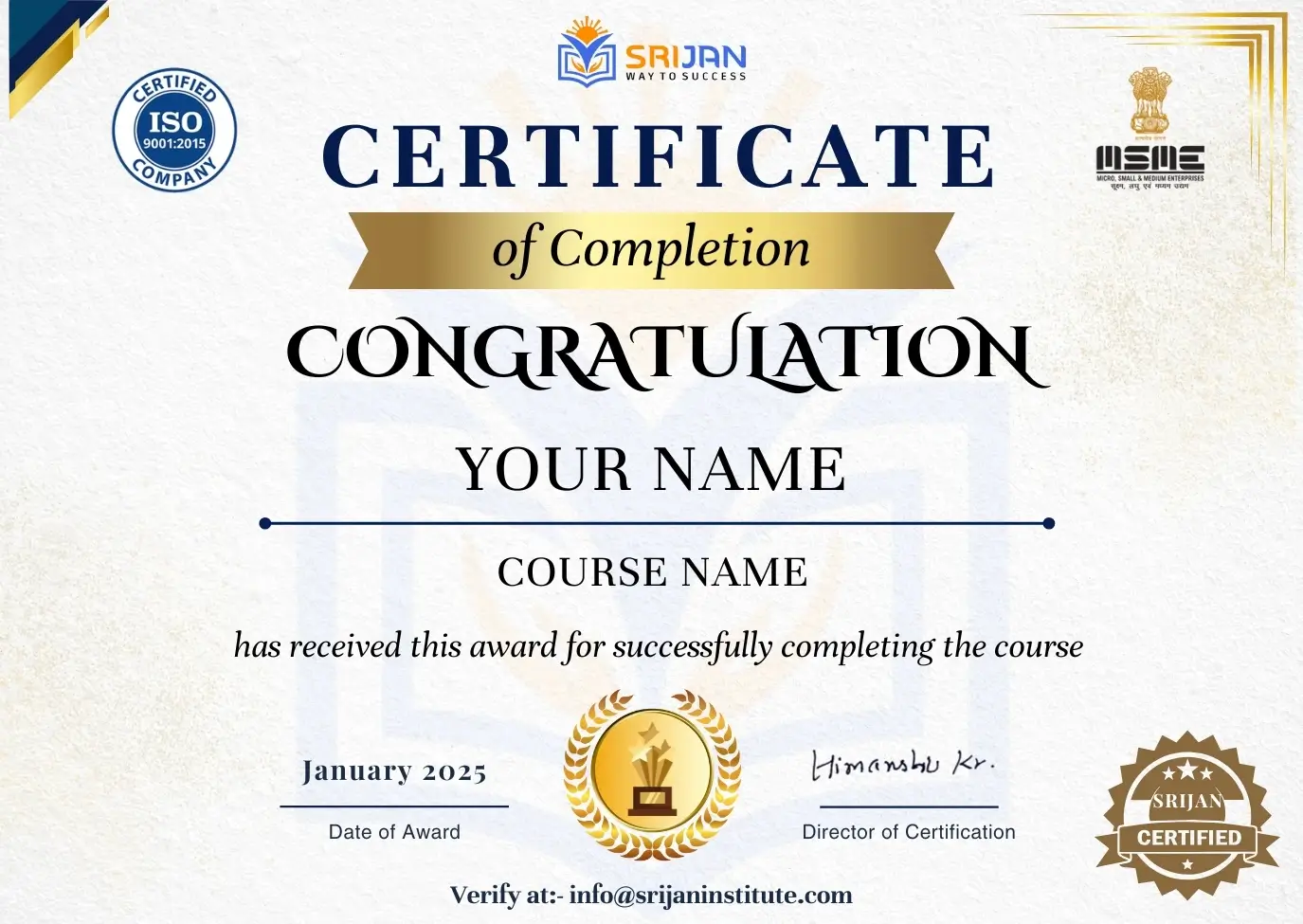
Our Hiring Partners
Our Popular Instructors
Meet our most talented and popular instructors

Mr. Manoj Pandey
SAP| MM| EWM|Ariba|erSAP Global Certified|SAP Consultant

Mr. Amrit Raj
Full Stack SAP Developer CUM ABAP On HANA Trainer | SAP BTP Developer | Full Stack Developer | ERP & Data Science| SAP Global Certified

Mr. Sudheer Sharma
SAP| FICO|Trainer|SAP Consultant

Priyanshu Panday
SAP Basis and Security Consultant

Buddhi Vishwas
SAP HCM and SAP Successfactor Consultant | Payroll | RCM | Employee Central
Choose Us
Why Choose Our SAP EWM Course
-
01
Broad Curriculum: Our SAP EWM Training provides comprehensive knowledge of the warehouse structure, inbound, warehouse management , and inventory management. Our end-to-end SAP EWM course makes you eligible to get SAP Certification.
-
02
Hands-on Practice: Get experience with real-time projects and case studies through our SAP EWM Course online. Simulations guarantee that concepts relate directly to business situations and warehouse operations.
-
03
Learn From The Best: Our Certified SAP trainers break down complex EWM processes into easy-to-follow information. Their coaching enables you to excel in both certification and career growth.
Choose Your SAP EWM Course Learning Plan
Pick the SAP EWM Course batch that best fits your schedule—ongoing, upcoming, and recorded options.
On-Going Batch
- First Batch Start Date: 11th November 2025
- Second Batch Start Date: 25th November 2025
($811)
Upcoming Batch
- First Batch Start Date: 9th December 2025
- Second Batch Start Date: 23rd December 2025
($811)
Learn At Your Own Pace
-
Enroll to access full recorded sessions, implementation notes, and completion certificate.
Self Paced Videos
Learn anytime, anywhere with our curated recorded courses
SAP EWM Course FAQs
As a Senior SAP EWM professional, you are able to make between ₹25 and 35 LPA. However, the final figure is determined by the conditions of the holder’s experience, skillset, and the company.
No, programming is not required. Good ERP skills will make the understanding easier, but it is not a must.
The average range is between ₹6 and 12 LPA, along with the level of experience and project skills being the deciding factors.
The cost of the certification exam is between ₹9,000 and ₹12,000.
To learn SAP EWM, one needs between 3 and 6 months, depending on the pace of study and previous ERP experience.
Level Up Your Skills with Our SAP EWM Course Today!
Unlock Your Career Potential with Our SAP EWM Course and Start Learning Today and Gain the Skills Employers Demand!


